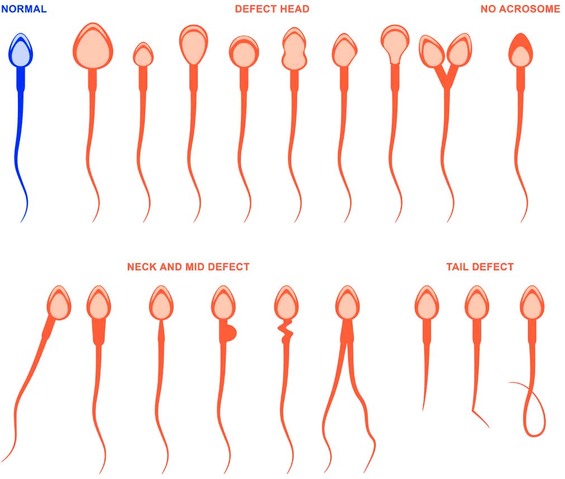

guidelines 2010, the reference value was updated. Traditionally, teratozoospermia was diagnosed if 14% of the sperm had a normal shape. Includes short, multiple, hairpin, broken or bent tails, coiled tails and terminal droplet, as well as a combination of these.


Includes bent neck, asymmetrical insertion of the midpiece into the head, irregular midsection, an abnormally thin and thick midsection, cytoplasmic droplet as well as a combination of these. Globozoospermia, where the head appears small and round due to the failure of the acrosome to develop. Includes large, small, tapered (elongated), pyriform (pear shaped), round, and amorphous (constricted) heads, vacuolated, heads with small cap area (< 40% of the head area) and double heads, as well as combination of these.

MISSHAPEN SPERM FREE
It should be free from any defect to fall under the category of normal sperm morphology. Normal sperm has an oval head with a long tail. 2010 cutoff parameters for a normal sperm count Parameter Moreover normal sperm count to get pregnant is between 15 million to 200 million sperm per millilitre. A sperm morphology, lower than 4 percent means it will take longer time to impregnate a female. The fertility rate is considered good when normal sperm morphology is in this range. Normal sperm morphology range varies between 4 to 14 percent. A man should at least, give two semen samples a few days apart to get an accurate result of semen analysis, which determines the sperm quality. From that semen sample, a drop of semen is taken in a clean, dry glass slide, and it is then dried, stained and observed under a microscope to determine the percentage of normal sperm in the total sample taken. Semen is the fluid containing sperm (plus other sugar and protein substances and secretions from other male accessory glands) that is released during ejaculation, and its main function is to fertilise a female ova or egg. For a semen analysis test, we need a fresh semen sample from a patient. A semen analysis test analyses the health and viability of a man’s sperm. Sperm Cell AnatomyĪ Sperm Morphology can be seen in a semen analysis test, also known as the sperm count test. And the diagnosis is dependent on the microscopical assessment and biochemical assays, which determines the quality of the semen. Traditionally, male fertility investigation relies on this standardised analysis of the semen parameters (morphology, motility, count). The results are reported as the percentage of sperm that appears normal when semen is viewed under a microscope. Morphology is one of the important factors that is examined as a part of a semen analysis test to evaluate male infertility along with sperm count and sperm motility. The tail is made up of protein fibres and helps the sperm to swim forward in the female genital tract to meet the egg. The mid-piece contains enzyme and multiple mitochondria which supplies energy to the sperm for the journey through the female cervix, uterus and uterine tubes. The head shape is most important because it carries the genetic information and affects the sperm’s ability to dissolve the outer surface of an egg and fertilise it. It basically looks at the shape and appearance of the sperm head, midsection, and tail. Sperm Morphology meaning refers to the shape and size of the sperm as observed under a microscope. Book An Appointment What is Sperm Morphology?


 0 kommentar(er)
0 kommentar(er)
